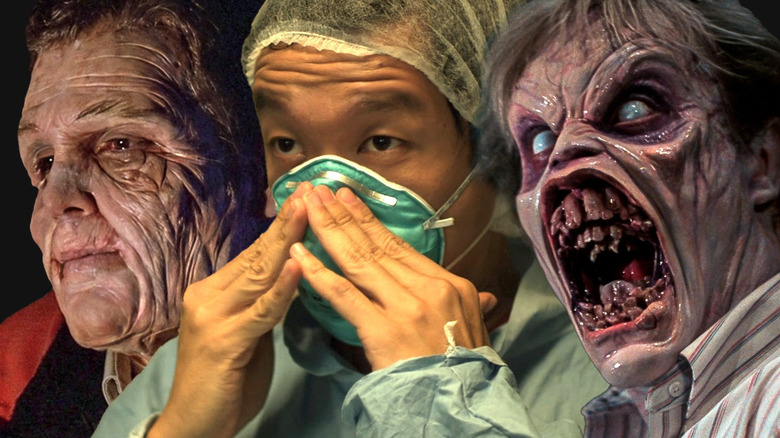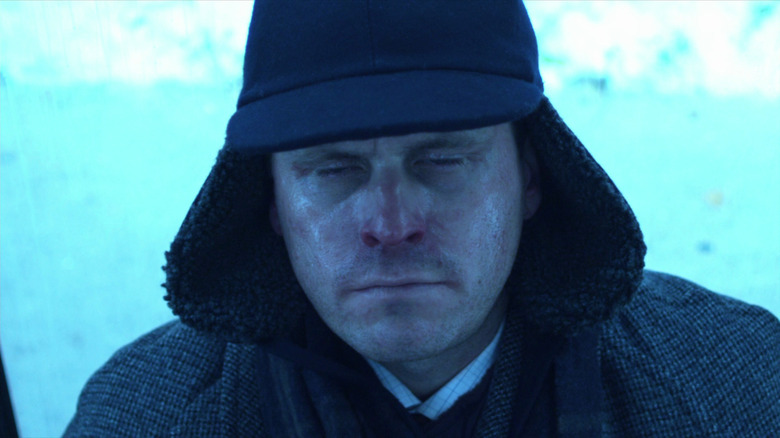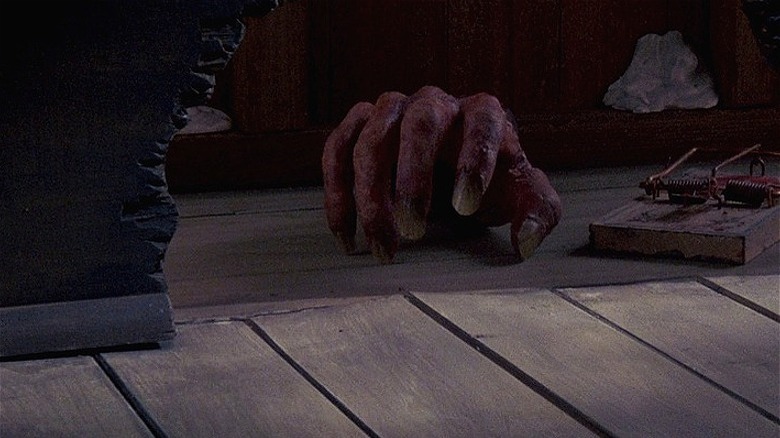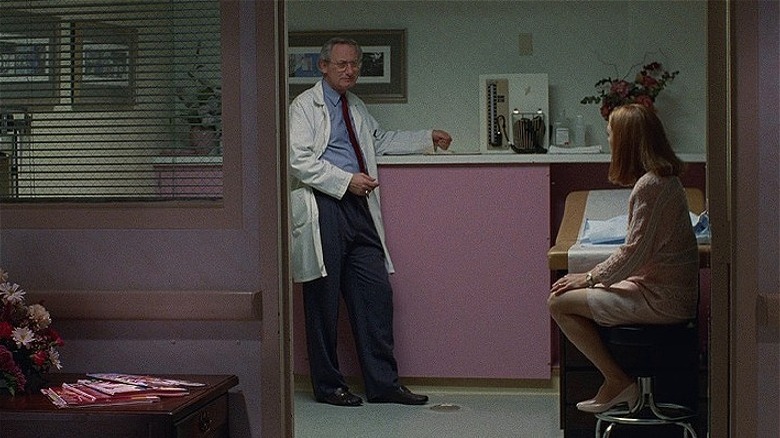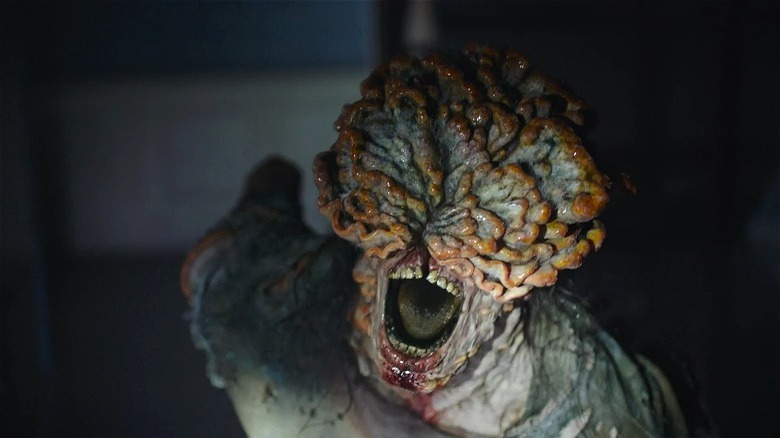Terrifying Diseases In Movies And TV That Are Actually Real
The following article includes discussions of acute medical conditions, mental health, and suicide.
After the past few years of the COVID-19 pandemic, it's entirely understandable that anybody would struggle to find interest in stories of disease and disorder. But the success of HBO's "The Last Of Us," an adaptation of the hit post-apocalyptic survival game by Naughty Dog, suggests we're beginning to open up again to stories about illness, loss, and the moral complexities of life on planet Earth.
Plenty of movies and television series deal with diseases, viruses, disorders, and other medical maladies. While they differ wildly in scientific accuracy, you'd be surprised how many writers, producers, and directors at least base them on real-world examples. Whether schlocky or well-researched, the media we produce and consume about illness can offer insight into our relationship with the forces of nature (and science).
We've isolated and quarantined some remarkable and/or terrifying examples of medical conditions that seem like they must have been entirely the creation of a Hollywood writer. Still, as the cliché goes, sometimes truth really is stranger than fiction.
Cabin Fever
In horror icon Eli Roth's directorial debut "Cabin Fever," a group of college students rents a cabin in the woods for a weekend off the grid, or so they hope. Instead, the city kids encounter irate locals and a highly infectious flesh-eating disease. Inspired by Roth's personal experience with skin infection while working on a horse farm as a teenager, it ranks as a gruesome, gleefully trashy flick — but we doubt you'd be laughing if you really caught necrotizing fasciitis.
"Cabin Fever" doesn't explicitly identify the disease, but there's an obvious real-life parallel. Aside from sounding like a Carcass song title, necrotizing fasciitis is a rare but aggressive and seriously life-threatening skin infection. If certain strains of bacteria like streptococci or staphylococcus find their way into an open wound on your body, you're at risk of developing this condition, which rapidly spreads through muscle and kills off surrounding tissue. It's incredibly painful, takes only days to wreak havoc, and isn't always obvious in its early stages.
Even if detected quickly, treatment of necrotizing fasciitis typically requires major surgery to remove all the infected tissue, meaning weeks or even months of intense nursing care and skin grafts. (Plus, you risk reinfection while in recovery.) Sure, "Cabin Fever" serves up some pretty gnarly stuff, like projectile blood vomit and a face-eating dog ... but at least those characters get put out of their misery. We'll just camp out in the backyard next time.
Contagion
When it comes to the magic of the movies, a little (or a lot) of suspension of disbelief may be required. That doesn't mean logic and facts must go out of the window in order to have a good time. In fact, the best films don't make you think about it at all. There's still something to be said for the writers who go the extra mile, though. And for "Contagion," Steven Soderbergh and Scott Z. Burns did exactly that.
The 2011 disaster thriller takes audiences through the terrifying spread of the MEV-1 pandemic across the globe. MEV-1 doesn't exist, but the virus and the science behind it — as well as humanity's multi-faceted response — was formulated in close collaboration with a number of experts in the subject, including journalist Laurie Garrett and Columbia University's W. Ian Lipkin. From its zoonotic origins to its transmission methods and symptoms, MEV-1 frighteningly resembles the Nipah virus, which has broken out numerous times since 1999.
"Contagion" boasts a top-tier ensemble cast including Matt Damon and Kate Winslet, but MEV-1 doesn't play favorites, killing off one of its biggest stars in the opening sequence. The film received praise from experts upon release, not only for its depiction of how viruses like MEV-1 function but also for its depiction of scientists reacting and responding to infectious diseases. It's a crying shame that the world's response to COVID-19 didn't unfold as smoothly as the movie. As Burns reflected to Vox, "We are all writing the sequel to 'Contagion' together."
Evil Dead 2
Of the many recurring motifs in the "Evil Dead" franchise, the possessed limb rates as one of our favorites. Natalie's self-surgery with an electric carving knife in the 2013 "Evil Dead" definitely scores points on the Gross-O-Meter, but you can't beat Ash Williams' slapstick battle with his own hand in "Evil Dead 2," in which he removes it with a chainsaw. But did you know that there's medical precedent for seemingly possessed limbs?
Of course, we're not dealing with the forces of the Necronomicon here. Early scientific study of the phenomena of "alien hand syndrome," in which a person's hand and/or arm appears to be acting of its own free will, is frequently attributed to German neurologist and psychiatrist Kurt Goldstein's 1908 paper on apraxia. In the century-plus since, there have been countless studies of patients experiencing AHS. Symptoms range from involuntary movement to the grasping of random objects, and much more extreme cases like scratching their owner.
No universal answer exists to the how and why of alien hand syndrome, but it typically manifests following a stroke, surgery to treat epilepsy, or as a result of neurodegenerative conditions affecting areas of the brain responsible for our motor skills. It's not uncommon for superstitious beliefs to fill gaps of explanation and education around medical phenomena, and scientists are tasked with bridging those gaps. Progress in fields like neuroscience in past decades is incredible, but many mysteries lie ahead of our best and brightest minds.
Safe
Writer/director Todd Haynes has received critical acclaim throughout his career, particularly for "Carol," which garnered six Oscar nominations back in 2015. But a lesser-known gem is Haynes' 1995 feature film "Safe," in which a Los Angeles housewife (Julianne Moore) begins to experience inexplicable bouts of chemical-related illness and seeks refuge within an isolated community. It's an eerie, thought-provoking work of fiction, but Haynes ripped the mysterious syndrome straight from the headlines.
Inspired by tabloid stories about "20th-century disease" and the experiences of those living with HIV/AIDS, the film follows a woman's struggle to figure out why she's seemingly incompatible with the modern world. Traffic fumes cause coughing fits, the hair salon leads to nosebleeds, and doctors offer no answers to her. In the real world, it's a condition that has been observed and studied for decades, typically as "multiple chemical sensitivity syndrome" or MCS. Symptoms range from changes in mood and cognitive function to anxiety and depression, and others across the immune, endocrine, and nervous systems.
In 2021, the INSPQ published an extensive analysis of more than 4,000 scientific articles concerning the syndrome. The report concluded that the nature of MCS is likely psychological rather than biological: severe anxiety stemming from a perceived sensitivity to chemicals. However, its impact on the day-to-day lives of those experiencing the condition is profound, warranting further study and treatment of patients. It's a fascinating medical anomaly, and Haynes' movie remains as insightful about what it means to be "sick" as ever.
The Happening
M. Night Shyamalan's survival horror film "The Happening" took a critical drubbing upon release in 2008. No matter what you think of Shyamalan's execution of the concept, the idea that an airborne toxin drives its victims to suicide en masse is a pretty frightening one — and believe it or not, nature's cooked up some nasty real-world parallels.
Feel free to look up images and video later if you're feeling morbidly curious, but for the sake of everybody else's lunch, we'll give you the Cliffs Notes on the hairworm. This parasite, more officially known as nematomorpha, forces its way into the bodies of invertebrates like crickets and grasshoppers in order to develop into adulthood. The worst part? Since they need a body of water to reproduce, the hairworm is known to influence its victims to seek out submersion, essentially drowning themselves. We're lucky they take no interest in vertebrates.
Something a little closer to home is toxoplasma gondii, a common parasite believed to be chronically present in up to a third of the world's population. While most of us will never experience symptoms associated with t. gondii, studies have linked inflammation caused by latent toxoplasmosis to psychiatric issues including schizophrenia and depression, and even suicidal behavior. As concerning as it all sounds, ongoing research into toxoplasmosis could potentially help a lot of people.
If you or someone you know needs help with mental health, please contact the Crisis Text Line by texting HOME to 741741, call the National Alliance on Mental Illness helpline at 1-800-950-NAMI (6264), or visit the National Institute of Mental Health website.
The X-Files, episode Død Kalm
In the show's second season, "The X-Files" sends FBI agents Mulder and Scully to the Norwegian Sea, where a U.S. military vessel and its crew appear to have aged rapidly with no explanation. After boarding the ship, the duo begins experiencing the same symptoms and must survive until help arrives. The culprit: contaminated seawater that causes rapid oxidation of the body's cells and hypernatremia. While writers Howard Gordon and Alex Gansa took "spooky" liberties with the science of accelerated aging — especially the makeup — the concept has its roots in the rational.
Medical conditions that emulate the effects of human aging are broadly labeled "progeroid syndromes," rare genetic disorders that include Hutchinson-Gilford progeria syndrome, Werner syndrome, and others. They're not something you catch. They typically result from a mutation within the body's genes. Such disorders affect hair growth, height, skin, heart, and joint health in ways that appear very similar to the results of normal aging.
Unfortunately, this also means people with accelerated aging syndromes typically don't survive very long due to heart disease and their body's impacted ability to carry out regular cell repair. As a result, diseases like progeria are a promising hotbed of research and study: scientists believe that advances in treatment for progeroid syndromes will not only improve the lives of those living with them but will open the door to further breakthroughs in understanding the human aging process as a whole.
Hannibal (NBC Series)
NBC's "Hannibal" television series depicted a lot of strange and nasty body stuff, most of it outside of a clinical setting. Bryan Fuller's re-imagining of the best-selling novel series ended far too soon, but it packed more gruesome oddities into each episode than most shows manage in an entire season. "Hannibal" generally leaned towards theatricality over realism — which was a feature, not a bug — but its inclusion of encephalitis was more steeped in reality than you might think.
Hugh Dancy's Will Graham might not be great with people outside of work, but as an FBI criminal profiler, he's one-of-a-kind. Graham experiences bizarre hallucinations, disorientation, and other symptoms revealed to be caused by advanced encephalitis, and they complicate his cat-and-mouse pursuit of Hannibal Lecter. Brain and/or spinal cord inflammation can lead to the body's immune system reacting to itself, resulting in symptoms not dissimilar to Will Graham's.
Despite seeming like something whipped up for the sake of a television audience, the clock-drawing test taken (and failed) by Graham is used by clinicians to detect conditions including encephalitis, Alzheimer's disease, and even high blood pressure. Given that it can lead to loss of hearing, sight, speech, and even permanent brain damage if not treated quickly, encephalitis is the real deal. The fact that Hannibal suspects Graham suffers from the condition and stays mum — just to see what happens to him — makes it that much more disturbing.
The Last of Us (HBO series)
"The Last of Us" epitomizes cross-media success. Since the original video game's release for the PlayStation 3 back in 2013, it's enjoyed a standalone story expansion, two extensive remasters, an ambitious sequel, and now a smash hit TV adaptation on HBO. Good reasons abound as to why this post-apocalyptic narrative resonates with so many people; as the show elaborated upon in the pilot episode, one of those reasons is that it's a premise not too far removed from reality.
The conceptually creepy Cordyceps fungus is responsible for the terrifying, zombie-like Infected in Naughty Dog's franchise. Of the many species of Cordyceps existing in nature, the team behind the game was chiefly inspired by the "zombie-ant fungus" Ophiocordyceps unilateralis, which infects its host by breaching its exoskeleton, enveloping and splitting its muscle tissue, and hijacking its body upon death to continue spreading its spores.
The "zombie" part, of course, really comes into focus with one of the fungi's methods of transmission: biting. In fact, these biting behaviors have been dubbed the "death grip," a technique useful in laying down an anchor so the ant's body can spread cordyceps spores all over the place — or just chomping down on their friends. This fungus is, thankfully, not transmissible to humans, but experts like Scott Roberts at the Yale School of Medicine have suggested that as the Earth's climate continually changes, being prepared for the unexpected would be wise.
